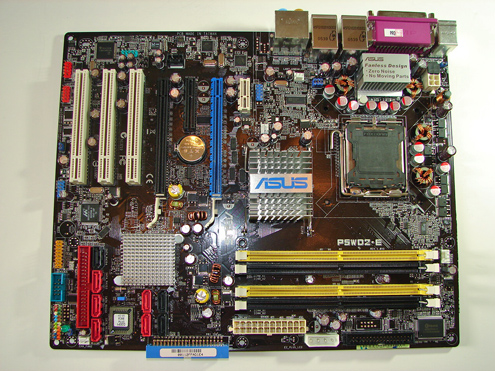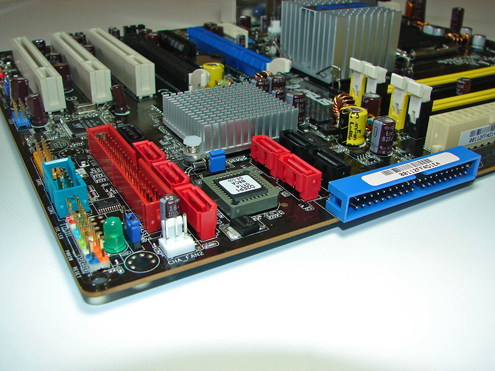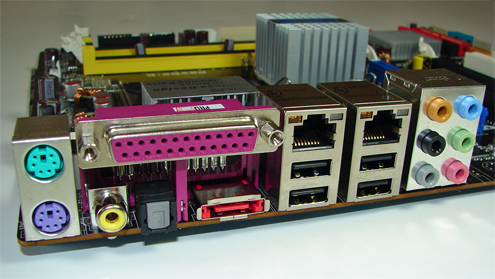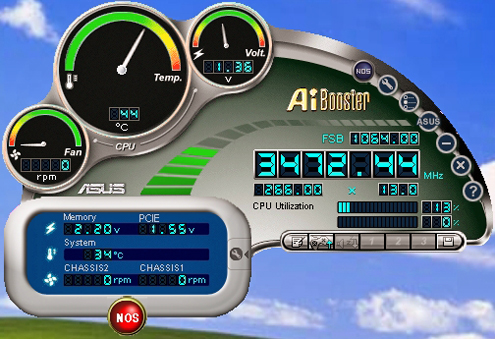Asus P5WD2-E Premium: Intel 975X for the Enthusiast
by Gary Key on January 16, 2006 12:05 AM EST- Posted in
- Motherboards
ASUS P5WD2-E: Features
The Intel SATA II ports are conveniently located below the ICH7R chipset and above the primary IDE connector. The SATA II ports feature the new clamp and latch design. Asus did not include the new cable designs in their accessory kit, which greatly enhance the security of the SATA connections. The SATA II ports are color coded for primary and secondary operation. We found the SATA 1 and 3 ports were partially blocked when utilizing the NVIDIA 7800GTX cards in both PCI-E x16 slots.
The Marvell 88SE6141 PATA port connector and Marvell 88SE6141 SATA II RAID port connectors are located to the left of the bios chip. The Intel USB connector, IEEE1394a connectors, chassis panel, and Com1 serial port are located along the left edge of the board. The CMOS reset is a traditional jumper design located above the bios chip.
We did not have any issues installing an ATI X850 Crossfire Edition setup in the two x16 PCI Express slots. This configuration will physically render the PCI-E x4 and the first PCI slot useless. We did not have any issues utilizing either slot with video cards containing single slot cooling systems.
The Northbridge and Southbridge chipsets are passively cooled with heatsinks that do not interfere with any installed peripherals. In fact this system kept the chipsets cool enough that additional chipset voltage was not a factor in our overclocking tests. Asus places the eight-pin 12v auxiliary power connector at the top of the CPU socket area but out of the way of most aftermarket cooling solutions.



The Intel SATA II ports are conveniently located below the ICH7R chipset and above the primary IDE connector. The SATA II ports feature the new clamp and latch design. Asus did not include the new cable designs in their accessory kit, which greatly enhance the security of the SATA connections. The SATA II ports are color coded for primary and secondary operation. We found the SATA 1 and 3 ports were partially blocked when utilizing the NVIDIA 7800GTX cards in both PCI-E x16 slots.
The Marvell 88SE6141 PATA port connector and Marvell 88SE6141 SATA II RAID port connectors are located to the left of the bios chip. The Intel USB connector, IEEE1394a connectors, chassis panel, and Com1 serial port are located along the left edge of the board. The CMOS reset is a traditional jumper design located above the bios chip.

We did not have any issues installing an ATI X850 Crossfire Edition setup in the two x16 PCI Express slots. This configuration will physically render the PCI-E x4 and the first PCI slot useless. We did not have any issues utilizing either slot with video cards containing single slot cooling systems.

The Northbridge and Southbridge chipsets are passively cooled with heatsinks that do not interfere with any installed peripherals. In fact this system kept the chipsets cool enough that additional chipset voltage was not a factor in our overclocking tests. Asus places the eight-pin 12v auxiliary power connector at the top of the CPU socket area but out of the way of most aftermarket cooling solutions.












20 Comments
View All Comments
Dfere - Thursday, May 18, 2006 - link
Just bought this and I am having a problem even getting this to post. Fans boot and HD starts to boot. No video image, monitor resets and then blanks.I stripped out unnecesary components- still no joy.
I have an Thermaltake XaserIII 480 with adapter and EZ 4 plug molex connected.
SATA 1 Port using WD 80 gig HD
Pentium D 805 w/ stock heatsink.
Inno3d 6200 TC video in 1st PCI 16 slot.
2X1 Gig PNY memory in Black series of slots.
I will be trying to use only one stock of memory, and then will be taking MB out of case and trying to boot on non-conducitve surface. Anyone else got advice?
TechJunkie - Friday, March 3, 2006 - link
I've had it now for almost a week and have started noticing problems. Many forums are now littered with complaints, mainly aimed at the Marvell issue.I mistakenly had set up my system the first time with the Intel chipset and using "Standard IDE"... system worked fine other than the issue with the Marvell. Benchmarks ran fine and 3DMark06 looked great.
I then reinstalled the OS, this time doing the PITA F6 procedure and set up the drives on the Intel controller using RAID (but didn't actually set up a RAID, simply wanted the AHCI with the ability to in the future set up RAID).
This morning I tried to run the 3DMark06 benchmark and while it ran to completion, the graphics screen seemed all corrupted throughout...I'm thinking power problem but it didn't have this issue last go around. Can setting up the drives differently have caused this from a power perspective or is this just one of the possibly many things wrong with this board?
I am wondering if I should RMA it back to zipzoom and get the Intel board, which has always been my choice, except this time the extra SATAII ports provided by the Marvell persuaded me to give ASUS a shot...ironic, isn't it!
In your opinion, based on what you know, will the issues with this board be resolved by BIOS/driver updates? It is a PITA to take my rig apart to swap out the motherboard but I will bite the bullet and get the Intel 975X board if this board can't be fixed via BIOS/driver updates.
medic91b2 - Monday, February 6, 2006 - link
I've had this m/b for a few week's and I have to say that it has many bug's in it. As far as i know, no one has gotten the marvell sata driver's to work and on the intel side people have gotten many mixed result's. I gave up trying to make a raid on this board. Asus support is nowere to be found, I think if any one want's to rate it then yhey should test all of the components of the boardGary Key - Saturday, February 11, 2006 - link
Email me and I will provide you with an updated bios that solves the USB issue and voltage spikes. I still have not had an issue with the Marvell RAID setup and two Raptors.
Zucker2k - Wednesday, February 15, 2006 - link
Gary,Could you please e-mail me the updated bios? email: qommonsense@gmail.com. Thanks.
Richard.
Joepublic2 - Wednesday, January 18, 2006 - link
As far as the motherboard goes, it looks pretty good. NB/SB are passively cooled, the layout is good and the MOSFETs are heatsinked (I've heard of problems with the voltage regulators on cheaper intel boards failing, often because they got too hot). I like how Anandtech's motherboard articles are very critical and mention things that other sites seem to glaze over, such as if the board's voltage regulator is three, four or eight phase.should read "processor's"
Gary Key - Thursday, January 19, 2006 - link
It is corrected. I had it marked on the final edit but missed it before publication, excuse the Homer moment please. :-) It is a good board but we felt like Asus did not go all the way on it and should have considering the price point. Although the board is not in retail yet we were somewhat disappointed with the bios also. Asus is working on a new release at this time and we hope to be able to test it in the next roundup.
ghg - Monday, January 23, 2006 - link
HiWhen may we expect the ANANDTECH 975x shootout ?
BR
Gary G.
Gary Key - Monday, January 23, 2006 - link
We should be finished in about three weeks. We have two additional boards in house and another two on their way. We will also have an overclocking shoot out with the Presler and Cedar Mill chips.
ghg - Friday, March 3, 2006 - link
HiAny news about the 975x shootout ?
BR
Gary G.